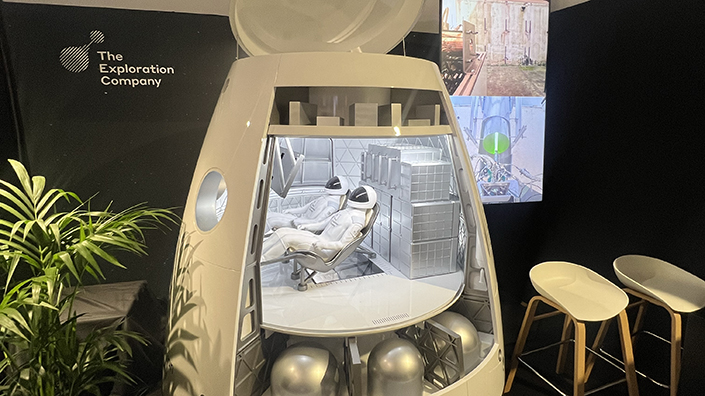Ultimately, the chemicals would not be used for their intended purpose, being studied for new ways to formulate shampoo using microgravity. Contact was lost with the capsule during its descent, before its parachutes could open. But the mission nonetheless marked several firsts – and its developer, The Exploration Company (TEC), aims to use the lessons learned in the creation of a next-generation capsule capable of carrying astronauts.
Formed in 2021 to build reusable space vehicles “for a cooperative future”, the Munich-headquartered firm developed its second launch – known as ‘Mission Possible’ – in just three years, for a cost of €30m. Launched on a SpaceX rocket and carrying a total of 25 payloads, which were powered on and off in orbit, it was the first private European capsule to deorbit and re-enter the atmosphere successfully in operational conditions. Every major system was validated before the final descent, when communications were lost 26km above the ocean.
Prioritising speed, iteration and cost-effectiveness, the high-risk mission was privately funded and led by industry. Rather than developing custom systems, TEC integrated off-the-shelf and flight-proven components – such as parachutes previously used on SpaceX’s Dragon capsule – to reduce qualification timelines and technical risks. It used a relatively cheap cork heat shield, which will be replaced by a cork-ceramic composite developed by the German Space Agency on future higher-velocity missions.
At first, the company is focused on cargo resupply missions to low Earth orbit (LEO), which means the International Space Station (ISS) for now. But with the ISS rapidly approaching its end of operational life in 2030, the company has also signed contracts with new commercial entrants Axiom, Starlab and Vast, “which are the future of LEO stations” according to Victor Maier, business lead for Germany and central Europe, who spoke to Professional Engineering at the Paris Air Show on 17 June.
The firm revealed further ambitions at the biennial event, unveiling a variant of its Nyx capsule that will be capable of carrying up to five crew. A model showed a distinctly minimalist design, with a pair of astronauts comfortably reclining in two ergonomic, lightweight chairs as they watch the monitors above. Behind them is a large pile of cargo, with the capsule door swinging open above.

The cut-away model, as seen at the Paris Air Show 2025
The first Nyx missions, planned from 2028, will not carry crew – but the company plans to show that the capsule could also be used for human spaceflight, Maier said, and it is already going through certification with Nasa. “We also have to certify for human spaceflight once we are docked on the station, because we have to provide life support when the astronaut goes inside,” he said. “We're already ticking some boxes for human spaceflight.”
The capsules are designed to bring up to 3,000kg of cargo down to Earth, the largest ‘down-mass’ available. The company hopes that missions will cost 25-50% less than other vehicles, making orbit accessible to both space and non-space companies.
Using variants of the same craft for both cargo deliveries and astronaut missions to LEO should simplify certification, Maier said. “You don't need to reinvent the vehicle again. You don't need to start from scratch. You already have a vehicle that's certified to do the docking; you have the docking mechanism.”
The most difficult part is the launch requirements for human spaceflight, he added, as the company needs to be able to guarantee the capsule can be ejected if the launch is aborted. This involves some “very expensive” tests, he said.
Engineers at the company are studying publicly released information about faults with the Boeing Starliner capsule, which stranded Nasa astronauts in space for nine months. Maier stressed the need for Europe, which is building the skills base needed for capsule development, to “go further” and secure human spaceflight capability.
Also operating in France and Italy, and with offices in Texas and the Middle East, the firm’s capsules are ‘launch agnostic’. It might seem surprising, therefore, that it is also developing several propulsion systems, including the Huracán rocket engine for its Nyx Moon capsule, smaller thrusters for capsule mobility and larger engines with thrust up to 250 kilonewtons. Those Storm and Typhoon engines will be sold to launch companies, however, targeting the growing market of launches to ‘mega-constellations’.
“If you want to really do that in Europe, then you need to understand that we need to act now,” Maier said. “I think it's good that we're looking into this, and we have the competency in the company to do that.”
Access to space has so far “been reserved for the happy few,” according to TEC’s website. “Our mission is to enable everyone to participate peacefully in the building of our human future.”
Want the best engineering stories delivered straight to your inbox? The Professional Engineering newsletter gives you vital updates on the most cutting-edge engineering and exciting new job opportunities. To sign up, click here.
Content published by Professional Engineering does not necessarily represent the views of the Institution of Mechanical Engineers.